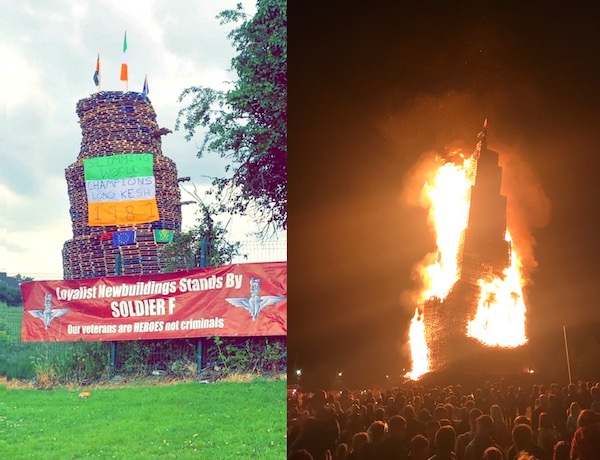
Despite large numbers of offensive and provocative displays at loyalist ‘Eleventh Night’ bonfires, a weekend of the sectarian events passed without serious trouble, easing tensions ahead of anti-Catholic marches later today by the Orange Order.
Rain and the final of the UEFA European Football Championship were credited with keeping crowds low at the notoriously dangerous events, held annually on the eve of the ‘Twelfth’, the height of the Protestant marching seasons.
The North’s fire service was used to damp down buildings in danger of catching fire in a number of locations. It said the service was more than three times as busy as two years ago, but that they had not come under attack from loyalists as in previous years.
The most contentious bonfire was built in the Tiger’s Bay area of north Belfast, adjacent to the nationalist New Lodge area. After weeks of attacks on the homes of New Lodge residents by the bonfire builders in advance of the ‘Eleventh’, it was topped with an Irish tricolour flag and burned at midnight on Sunday, but without significant trouble at the interface.
Unionist leaders attended the site and controversially endorsed the fire, which was illegally built on government-owned land overlooking the homes of nationalists. Among those who lent their support were DUP leader Jeffrey Donaldson and UUP leader Doug Beattie.
The PSNI had warned of loyalist violence if it had taken action against the bonfire after reports of UDA paramilitary activity in the area.
A court bid to overcome the PSNI’s refusal to move the bonfire by two Stormont ministers, Infrastructure Minister Nichola Mallon of the SDLP and Communities Minister Deirdre Hargey of Sinn Féin took place on Friday.
Minister Hargey’s argument that local residents had “the right to live free from attacks on their homes and free from intimidation and anti-social behaviour” was rejected by a High Court judge, however, citing the PSNI’s concerns of violence.
Sinn Féin Deputy First Minister Michelle O’Neill denounced the ruling and the PSNI’s failure to take action.
She said: “Why is it acceptable to anyone in this day and age that [the UDA’s] threat is more dominant than the rights of the citizens that are being attacked in these areas?”
She said that bonfires in interface areas invited tension.
She said: “Putting a bonfire on an interface area does beg the question: Is it there only to antagonise? These bonfires should not be happening in interface areas.
“Those who want to celebrate the Twelfth, that’s absolutely their entitlement, they should do that, but bonfires in interface areas are not acceptable.
Other bonfires lit this weekend delivered a range of sectarian hate messages, including the burning of figures in effigy, placards from Gaelic sports clubs, banners from nationalist justice campaigns and flags of republican organisations, as well as EU flags. The Irish national flag was burned atop almost every bonfire.
As usual there there was no criticism of the hate displays by unionist politicians, although efforts by the mainstream media to normalise the scenes were noticeably down on previous years.
Loyalist activist Jamie Bryson was widely criticised after he tweeted a picture of a bonfire with a huge Irish tricolour and praised the “good family atmosphere”, hours before the flag and pyre were both incinerated.
The largest Eleventh Night bonfire was erected on the outskirts of Larne, and was symbolically burned with the Starry Plough flag of Irish republican socialism on top.
In Limavady, County Derry, an Eleventh Night pyre was fully painted in the colours of the Irish flag, but was set alight early. Sinn Féin’s East Derry Assembly member Caoimhe Archibald had described it as “an expression of hate”.
Sinn Féin and Alliance politicians also particularly condemned the placing of party election posters on a bonfire in Portadown. Irish and Palestinian flags were also erected at the top of the towering structure on Saturday night alongside election posters of Sinn Féin council candidate Callum O’Dufaigh and Alliance leader Naomi Long.
Sinn Féin Assembly member John O’Dowd said the incident should be investigated as a hate crime.
“As Callum O’Dufaigh celebrated his 21st birthday party in another part of his home town others were burning his image on a bonfire,” Mr O’Dowd added.
“The organisers and supporters of such bonfires cannot have it both ways. It’s either culture or a hate crime it can’t be both!”
The giant bonfire fell burning into fleeing crowds as it toppled on Friday night, with a miraculous escape for those present. The Upper Bann representative hit out at the scenes.
“Videos continue to emerge in social media of screaming crowds running for their lives as the towering inferno collapses towards them,” he said.
“The PSNI needs to explain why crowds were allowed to gather in the shadow of a potential death trap, what engagement was there between police, the Fire Service and organisers in the days and hours leading up to the pyre being lit. And will there be any criminal investigations into why so many lives were placed in danger.
“The primary role of a policing service is to protect lives and property. In this instance both were placed in real danger in the full view of the police.”
![[Irish Republican News]](https://republican-news.org/graphics/title_gifs/rn.gif)
![[Irish Republican News]](https://republican-news.org/graphics/title_gifs/harp.gif)

